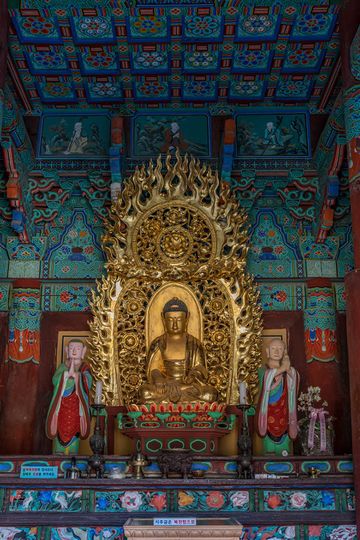김제 금산사 대장전 목조삼존불상과 광배
| 김제 금산사 대장전 목조삼존불상과 광배 Wooden Buddha Triad and Mandorla in Daejangjeon Hall of Geumsansa Temple, Gimje |
|
| 대표명칭 | 김제 금산사 대장전 목조삼존불상과 광배 |
|---|---|
| 영문명칭 | Wooden Buddha Triad and Mandorla in Daejangjeon Hall of Geumsansa Temple, Gimje |
| 한자 | 金堤 金山寺 大藏殿 木造釋迦三尊佛像 및 光背 |
| 주소 | 전라북도 김제시 금산면 모악15길 1 |
| 지정(등록) 종목 | 전라북도 유형문화재 제253호 |
| 지정(등록)일 | 2017년 11월 03일 |
| 수량/면적 | 1점 |
| 웹사이트 | 김제 금산사 대장전 목조삼존불상과 광배, 국가문화유산포털, 문화재청. |
|
|
|
해설문
국문
석가모니 부처님이 한가운데 앉아 있고, 왼쪽에는 가섭존자, 오른쪽에는 아난존자의 입상으로 구성되어 있다. 목조불상 바닥에 기록된 내용으로 보아 1,600년 초~중기 작품으로 추정된다. 가섭상은 노숙한 스님, 아난상은 젊은 스님을 잘 표현하고 있다. 부처님의 몸 전체에서 발산되는 밝은 빛을 화려하고 정교한 형태의 광배로 제작하였다. 보존 상태가 매우 양호하고, 장식이 너무 아름답기 때문에 불교조각 연구에 귀중한 자료로 평가된다.
영문
Wooden Buddha Triad and Mandorla in Daejangjeon Hall of Geumsansa Temple, Gimje
This wooden Buddha triad is presumed to have been made in the 17th century during the Joseon period (1392-1910). A statue of Sakyamuni Buddha is placed in the center and two of his disciples, namely the experienced monk Maha Kasyapa and the young monk Ananda, are to his left and right, respectively.
The Buddha's right hand reaches down toward the ground and his left hand rests on his lap, symbolizing the attainment of spiritual enlightenment. The halo behind the Buddha, called a mandorla, represents the bright light that radiates from his entire body, and was therefore crafted in an exquisite and splendid manner. This triad is in very good condition and is therefore a precious resource in the study of Buddhist sculpture.
영문 해설 내용
이 삼존불상은 조선시대인 17세기에 만들어진 것으로 추정된다. 가운데 석가모니불을 중심으로 양옆에는 석가모니의 두 제자가 배치되어 있는데, 왼쪽의 노숙한 스님은 가섭존자, 오른쪽의 젊은 스님은 아난존자를 나타낸 것이다.
석가모니불의 오른손은 땅을 향하고 있고 왼손은 무릎 위에 있는데, 이는 석가모니가 깨달음을 얻은 순간을 상징한다. 광배는 몸 전체에서 발산되는 밝은 빛을 나타내며, 화려하고 정교한 형태로 제작되었다. 보존 상태가 매우 양호하여 불교 조각 연구에 귀중한 자료로 평가받는다.
